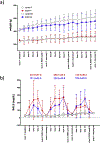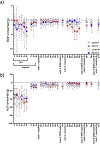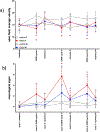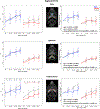Multi-modal imaging reveals differential brain volumetric, biochemical, and white matter fiber responsivity to repeated intermittent ethanol vapor exposure in male and female rats
- PMID: 32240669
- PMCID: PMC8143804
- DOI: 10.1016/j.neuropharm.2020.108066
Multi-modal imaging reveals differential brain volumetric, biochemical, and white matter fiber responsivity to repeated intermittent ethanol vapor exposure in male and female rats
Abstract
A generally accepted framework derived predominately from animal models asserts that repeated cycles of chronic intermittent ethanol (EtOH; CIE) exposure cause progressive brain adaptations associated with anxiety and stress that promote voluntary drinking, alcohol dependence, and further brain changes that contribute to the pathogenesis of alcoholism. The current study used CIE exposure via vapor chambers to test the hypothesis that repeated episodes of withdrawals from chronic EtOH would be associated with accrual of brain damage as quantified using in vivo magnetic resonance imaging (MRI), diffusion tensor imaging (DTI), and MR spectroscopy (MRS). The initial study group included 16 male (~325g) and 16 female (~215g) wild-type Wistar rats exposed to 3 cycles of 1-month in vapor chambers + 1 week of abstinence. Half of each group (n = 8) was given vaporized EtOH to blood alcohol levels approaching 250 mg/dL. Blood and behavior markers were also quantified. There was no evidence for dependence (i.e., increased voluntary EtOH consumption), increased anxiety, or an accumulation of pathology. Neuroimaging brain responses to exposure included increased cerebrospinal fluid (CSF) and decreased gray matter volumes, increased Choline/Creatine, and reduced fimbria-fornix fractional anisotropy (FA) with recovery seen after one or more cycles and effects in female more prominent than in male rats. These results show transient brain integrity changes in response to CIE sufficient to induce acute withdrawal but without evidence for cumulative or escalating damage. Together, the current study suggests that nutrition, age, and sex should be considered when modeling human alcoholism.
Keywords: Diffusion tensor imaging; Liver; Magnetic resonance spectroscopy; White matter; behavior; repeated withdrawal.
Copyright © 2020 Elsevier Ltd. All rights reserved.
Conflict of interest statement
Declaration of Competing interest The authors have no conflicts of interest to declare.
Figures







Similar articles
-
Transient CNS responses to repeated binge ethanol treatment.Addict Biol. 2016 Nov;21(6):1199-1216. doi: 10.1111/adb.12290. Epub 2015 Aug 18. Addict Biol. 2016. PMID: 26283309 Free PMC article.
-
A combined diffusion tensor imaging and magnetic resonance spectroscopy study of patients with schizophrenia.Schizophr Res. 2016 Feb;170(2-3):341-50. doi: 10.1016/j.schres.2015.12.003. Epub 2015 Dec 21. Schizophr Res. 2016. PMID: 26718333 Free PMC article.
-
Dynamic responses of selective brain white matter fiber tracts to binge alcohol and recovery in the rat.PLoS One. 2015 Apr 20;10(4):e0124885. doi: 10.1371/journal.pone.0124885. eCollection 2015. PLoS One. 2015. PMID: 25894968 Free PMC article.
-
Neuroimaging in alcohol use disorder: From mouse to man.J Neurosci Res. 2022 May;100(5):1140-1158. doi: 10.1002/jnr.24423. Epub 2019 Apr 22. J Neurosci Res. 2022. PMID: 31006907 Free PMC article. Review.
-
Alcohol's Effects on the Brain: Neuroimaging Results in Humans and Animal Models.Alcohol Res. 2017;38(2):183-206. Alcohol Res. 2017. PMID: 28988573 Free PMC article. Review.
Cited by
-
Jacobian Mapping Reveals Converging Brain Substrates of Disruption and Repair in Response to Ethanol Exposure and Abstinence in 2 Strains of Rats.Alcohol Clin Exp Res. 2021 Jan;45(1):92-104. doi: 10.1111/acer.14496. Epub 2020 Nov 20. Alcohol Clin Exp Res. 2021. PMID: 33119896 Free PMC article.
-
Alcohol Use Disorder and Dementia: A Review.Alcohol Res. 2024 May 23;44(1):03. doi: 10.35946/arcr.v44.1.03. eCollection 2024. Alcohol Res. 2024. PMID: 38812709 Free PMC article. Review.
-
Alcohol use disorder: Neuroimaging evidence for accelerated aging of brain morphology and hypothesized contribution to age-related dementia.Alcohol. 2023 Mar;107:44-55. doi: 10.1016/j.alcohol.2022.06.002. Epub 2022 Jul 1. Alcohol. 2023. PMID: 35781021 Free PMC article. Review.
-
Operant ethanol self-administration behaviors do not predict sex differences in continuous access home cage drinking.Alcohol. 2025 Mar;123:87-99. doi: 10.1016/j.alcohol.2024.08.004. Epub 2024 Aug 31. Alcohol. 2025. PMID: 39218047
-
Age differences in brain structural and metabolic responses to binge ethanol exposure in fisher 344 rats.Neuropsychopharmacology. 2021 Jan;46(2):368-379. doi: 10.1038/s41386-020-0744-6. Epub 2020 Jun 24. Neuropsychopharmacology. 2021. PMID: 32580206 Free PMC article.
References
-
- Alexander-Kaufman K, Cordwell S, Harper C, Matsumoto I, 2007. A proteome analysis of the dorsolateral prefrontal cortex in human alcoholic patients. Proteomics Clin Appl 1, 62–72. - PubMed
-
- Backstrom P, Bachteler D, Koch S, Hyytia P, Spanagel R, 2004. mGluR5 antagonist MPEP reduces ethanol-seeking and relapse behavior. Neuropsychopharmacology : off publ Am Coll Neuropsychopharmacology 29, 921–928. - PubMed
-
- Ballenger JC, Post RM, 1978. Kindling as a model for alcohol withdrawal syndromes. The British journal of psychiatry : J. Ment. Sci 133, 1–14. - PubMed
Publication types
MeSH terms
Substances
Grants and funding
LinkOut - more resources
Full Text Sources

